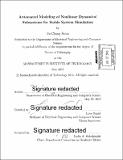Automated modeling of nonlinear dynamical subsystems for stable system simulation
Author(s)
Hsiao, Yu-Chung, Ph. D. Massachusetts Institute of Technology
DownloadFull printable version (12.00Mb)
Other Contributors
Massachusetts Institute of Technology. Department of Electrical Engineering and Computer Science.
Advisor
Luca Daniel.
Terms of use
Metadata
Show full item recordAbstract
Automated modeling techniques allow fast prototyping from measurement or simulation data and can facilitate many important application scenarios, for instance, shortening the time frame from subsystem design to system integration, calibrating models with higher-order effects, and providing protected models without revealing the intellectual properties of actual designs. Many existing techniques can generate nonlinear dynamical models that are stable when simulated alone. However, such generated models oftentimes result in unstable simulation when interconnected within a physical network. This is because energy-related system properties are not properly enforced, and the generated models erroneously produce numerical energy, which in turn causes instability of the entire physical network. Therefore, when modeling a system that is unable to generate energy, it is essential to enforce passivity in order to ensure stable system simulation. This thesis presents an algorithm that can automatically generate nonlinear passive dynamical models via convex optimization. Convex constraints are proposed to guarantee model passivity and incremental stability. The generated nonlinear models are suited to be interconnected within physical networks in order to enable the hierarchical modeling strategy. Practical examples include circuit networks and arterial networks. It is demonstrated that our generated models, when interconnected within a system, can be simulated in a numerically stable way. The system dynamics of the interconnected models can be faithfully reproduced for a range of operations and show an excellent agreement with a number of system metrics. In addition, it is also shown via these two applications that the proposed modeling technique is applicable to multiple physical domains.
Description
Thesis: Ph. D., Massachusetts Institute of Technology, Department of Electrical Engineering and Computer Science, 2015. Cataloged from PDF version of thesis. Includes bibliographical references (pages 107-113).
Date issued
2015Department
Massachusetts Institute of Technology. Department of Electrical Engineering and Computer SciencePublisher
Massachusetts Institute of Technology
Keywords
Electrical Engineering and Computer Science.